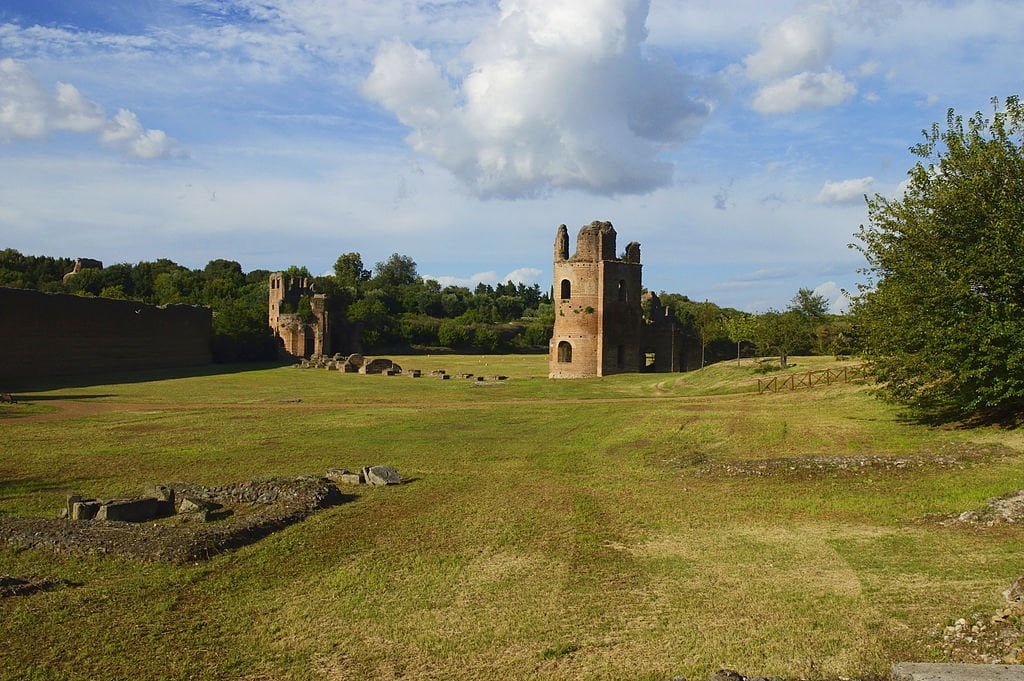Chapters
Via Appia (Appian road), also called Via Appia Antica, was one of the oldest Roman roads We can admire numerous fragments of it to this day. The total length of the Appian road is over 530 km, which proves how well developed the Roman Empire was.
In Roman times, via Appia was called “the queen of roads” (regina viarum)1. Its run started in Rome at Circus Maximus, then went south, to Capua near Naples, from there to the east and end in Brundisium (now Brindisi) on the Adriatic. There, during the empire, via Appia connected with Via Traiana – the route which was an extension of the Appian road with Beneventum to Brundisium via Canusium, Butuntum, and Barium. In Beneventum the route was crowned with an arch.
Via Appia can be compared with the highways that are currently under construction. It is also the first Roman road so well certified in sources.
Building via Appia
The construction of the Appian Road was started in 312 BCE by the then censor Appius Claudius Caecus, a supporter of Rome’s southern expansion. Upper Campania was in the hands of the Romans, and to meet the Samnites (mountain, valiant people), Rome wanted to fortify itself by conquering the rest of the region. The Appian Way was created mainly for military purposes – it was to allow soldiers to move quickly and ensure a steady supply of new recruits in the war with the Samnites in the south. Largely thanks to the rapid replenishment of supplies and losses, the Romans were able to defeat the enemy in the Second Samnite War (327-304 BCE). In 264 BCE the Appian road led to Brundisium, on the Adriatic Sea.
Another reason for the treasury’s heavy burden on the construction of such a long road was the desire to strengthen trade and links between the regions, and especially the stronger integration of Campania with Rome.
Via Appia was not the first Roman road, but it was certainly the most impressive, one of the oldest and the first one to be strengthened on the basis of crushed stone and cobblestones (munita). Moreover, it was the first Roman road that was named after a builder, and not the way it played so far – e.g. Via Salaria (the road from which salt was imported).
The construction of the main part of the road began and was completed in 312 BCE. It was a levelled compact dirt road with a layer of (1) small stones and gravel, and then (2) large stones bonded with cement lime mortar. The Binzatin historian Procopius argued that the top layer was so folded that it could be considered as one common element rather than the joined fragments. The surface was apparently extremely even – throughout history, the cement between the stones has been eroded and hence the surface is very uneven. The road in the central part was slightly convex, and on the sides, there were special drainage ditches, which ensured proper drainage of rainwater.
The first paved section was created by the brothers Quintus and Gnaeus Ogulnius – curule aediles – who in 296 BCE ordered the paving of the Appian road to the temple of Mars. It was about 100 meters after the first milestone2. Although the Appian Way started its course at the Great Circus, its distance was measured from the gate of the Servian Wall – Porta Capena. Finally via Appia was completely paved at the end of the 2nd century BCE
How did the Appian Way lead?
The Via Appia started at the Great Circus and left the city through the gate of the Servian Wall – Porta Capena – and led through the suburbs. The route then ran straight through the Albanian Mountains, which made the road steep at times, and then through the former Pontina Mud (Paludes Pontinae). Through the smelly swamps (attempts were made to drain them, e.g. for Claudius, but it was only possible in the 20th century), he led a 31 km stone section, which required constant repairs. Over time, a replacement road was created – a canal commissioned by Marcus Cornelius Cathegus in 162 BCE – which was more favoured by travellers when crossing swamps.
Then, from the town of Tarracina, via Appia it followed the wharf and turned slightly north to Capua. This is also where the early form of the Appian Road ended, the total length of which was 212 km. In the beginning, there were no milestones along the road, as they began to be set in later times.
Triumphant for Rome, the Third Samnite War (298-290 BCE) brought the Samnites under Roman authority and the creation of 13 new colonies in Campania and Samnium. With the expansion of the Roman sphere of influence, it was decided to extend via Appia by another 56 km, to then reach Venusia,
In 282-272 BCE there was a clash of Roman troops with Pyrrhus and Tarentum. After heavy battles and great supply difficulties (via Appia played a huge role), the Romans managed to defeat the king of Epirus and subjugate the Greek city. With the victory, the Appian Way was extended to Brundisium in 264 BCE
Later, during the reign of Trajan, the said Via Traiana was created. This route extended the Appian Way from Brundisium to Beneventum.
Although via Appia was rebuilt or extended many times, it was named after the first builder – Appius Claudius.
Buildings on the Appian road
As Roman law forbade burying the dead in the city, the Romans decided to bury the dead and put them in monuments as close as possible. Thus, there were a lot of tombs along the road, especially at the first milestones.
One can distinguish, for example, the tomb of the Scipio, which was created in about 280 BCE. There are 9 sarcophagi in it; unfortunately, the famous member of the family is missing, the winner from Zama – Scipio Africanus the Elder. He was buried in the city of Liternum (Campania), the place of his death.
Near the Scipio tomb, there is Pomponius Hylas’ columbarium from the end of the 1st century BCE. Columbaria were largely underground, which made it possible to hide the ashes of many people in a small space. It was one of the earlier constructs of this type that was especially popular during the reign of Octavian Augustus (27 BCE – 14 CE).
A very impressive tomb, located via Appia, was the mausoleum of Cecilia Metelia. The object, 11 meters wide, dates back to the 1st century BCE. The woman came from a noble lineage of Metellus and her husband was the son of a great coffin – Marcus Crassus. Another important tomb was Casal Rotondo, on the way to Brundisium.
Apart from tombs and mausoleums – with the spread of Christianity – catacombs began to appear along the road, including: St. Callixtus, St. Sebastian, St. Pretext.
At via Appia there are also remains of the Villa of Maxentius, which was originally only a villa, but under Maxentius, it was extended with a mausoleum and a circus. The arena was so large that even 12 chariots could race on it, and even 10,000 people could sit in the stands.
Other facilities a fifth mile from the city include: the Roman baths Capo di Bove, the Church of Domine Quo Vadis, the Villa of Quintilii with a nymphaeum, theatre and baths, the Temple of Hercules, the villa of Publius Clodius Pulcher and the villa of Pompey
On the Appian road, you can also come across the remains of several Roman bridges: Ponte di Tre Ponti, Ponte di Vigna Capoccio, Viadotta di Valle Ariccia, Ponte Alto or Ponte Antico.
Famous events from antiquity
- In 73 BCE there was a slave uprising led by Spartacus. For two years, the Roman legions were unable to defeat a well-led army of slaves. It was not until 71 BCE in southern Italy that the cornered Spartacus suffered a decisive defeat and lost his life. The Roman authorities, shocked by the “insolence” and resistance of the slaves, decided to impose a very “expressive” punishment on the rebels alive. According to Roman historians, about 6,000 slaves were crucified along via Appia – over a distance of 200 km, between Capua and Rome. It was meant to be a warning to others wanting to oppose the Roman rule.
- In January 52 BCE, at the height of the ancient city of Bovillae (19 km from Rome), there was a clash between militias of rival politicians – Clodius Pulcher (popular) and Titus Annius Milo (optimate). As a result, the beloved Pulcher tribune, whose funeral became a huge demonstration in Rome, died.
Currently
Many parts of the Appian road are still in use today, even by cars – as in the city of Velletri. Interestingly, to this day via Appia is the longest straight road in Europe, 62 km long.










